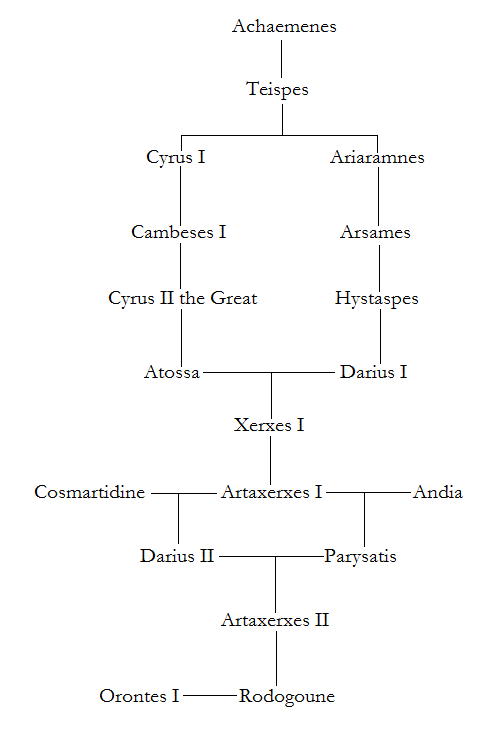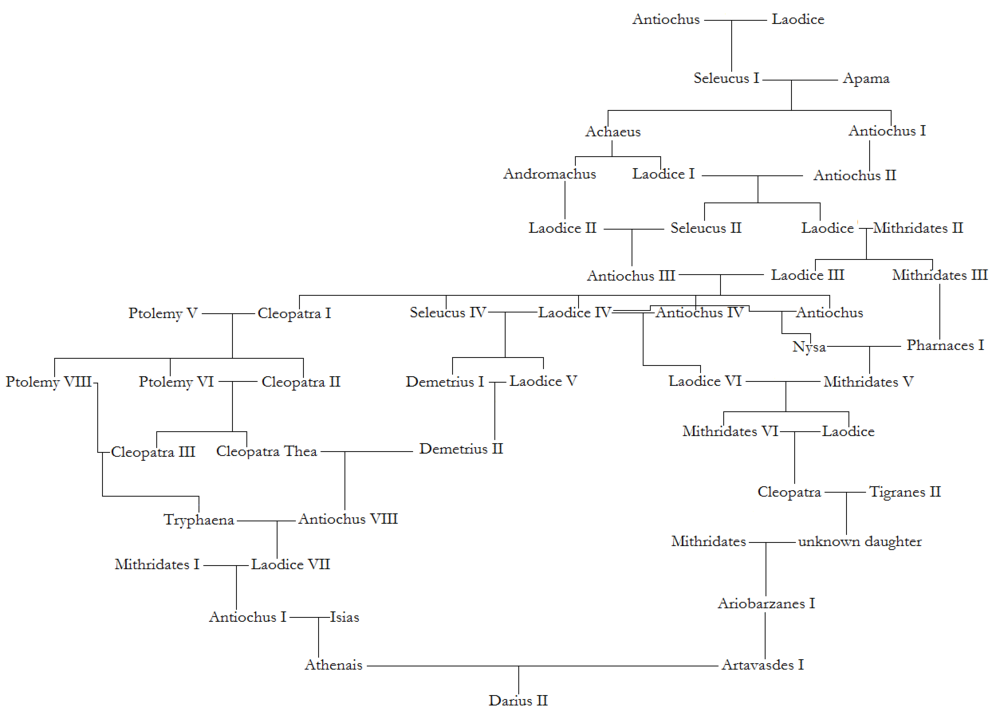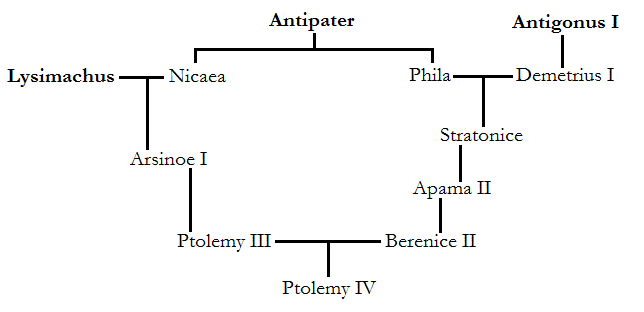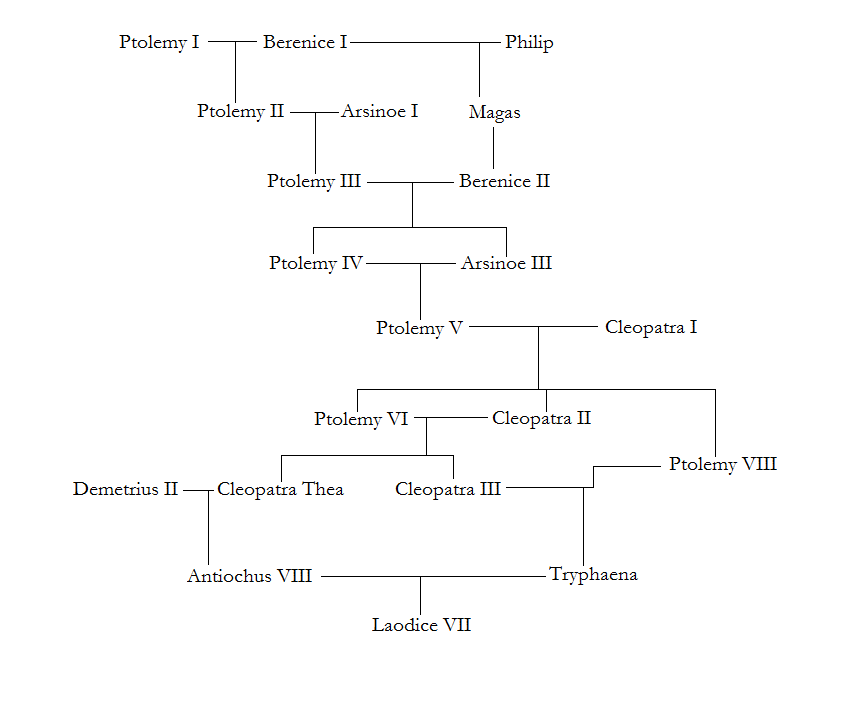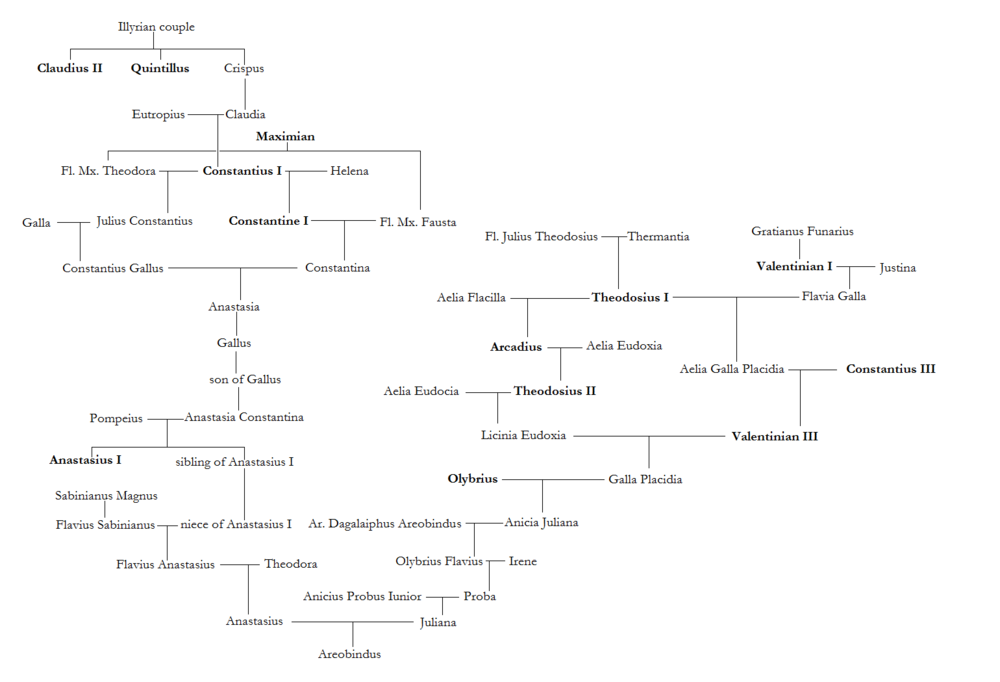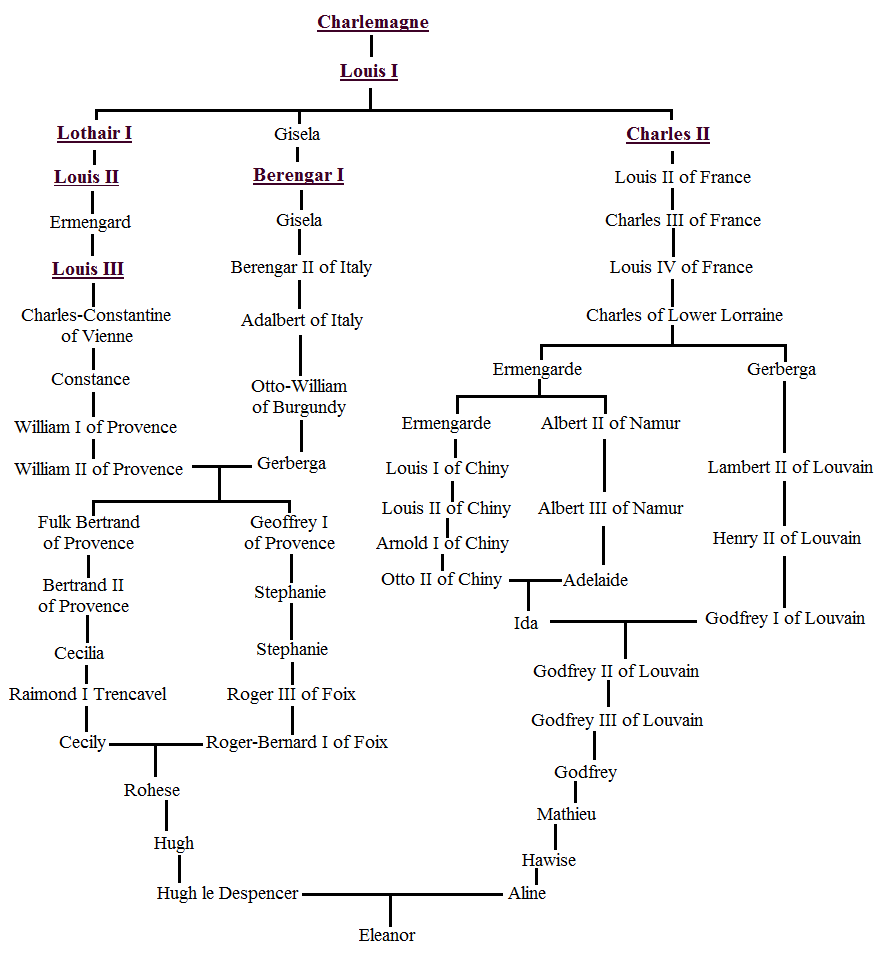Royal ancestry of the House of Austen

This article documents the descent of the House of Austen from various royal and imperial dynasties. The House of Austen is the founding dynasty of the Empire of Austenasia; due to a family legend that their ancestors included Roman Emperors, the Parliament of Austenasia on 10 January 2009 passed a law directing the Secretary-General to undertake genealogical research into the ancestry of the Imperial Family. By March 2015, this research had resulted in descent from antiquity having been established, with lines of descent found not just from Roman Emperors, but from the monarchs and dynasties of many other polities, both ancient and medieval.
The royal descent of the House of Austen is through one Elizabeth Vane (1691-1767), who married Edward Austen (1686-1755) in 1711. The couple lived in Tenterden, Kent, and had four children: Thomas, John, Elizabeth, and Mary. John Austen (1716-1777) moved to Deal, where he and his family lived until circa the 1810s, when his grandson, also named John (b. 1779), moved to the East End of London. His descendants continued to live there, working on the docks, until the mid-1930s when the second John's great-great grandson David Austen (1900-1983) and David's son - also named David (1927-2008) - moved to Carshalton; these Davids were the grandfather and father respectively of Terry I, Emperor of Austenasia, the current Head of the House of Austen.
Elizabeth Vane's ancestors are those through whom the royal descent of the House of Austen has been able to be traced, and so it is to her that the pedigrees in this article are linked. Her special status in this regard was recognised by law on 14 October 2015, when the Succession to the Throne Act 2015 was passed. Paragraph 10 of this Act provides for the descendants of Elizabeth and her husband to be given preference over all other relatives of previous Austenasian Monarchs in regards to choosing a new Emperor or Empress should the line of succession to the Austenasian Throne ever come to an end.
Macedonian (9th-5th centuries BC)
The House of Austen is descended from a patrilineal succession of ten members of the Argead dynasty, the ruling dynasty of Macedon which eventually produced Alexander the Great.

- Karanos (r. c. 808-778 BC)
- Koinos (r. c. 778-750)
- Tyrimmas (r. c. 750-700)
- Perdiccas I (r. c. 700-678)
- Argaeus I (r. 678-640)
- Philip I (r. 640-602)
- Aeropus I (r. 602-576)
- Alcetas I (r. 576-547)
- Amyntas I (r. 547-498)
- Alexander I (r. 498-454)
Alexander I of Macedon (not to be confused with Alexander (III) the Great, his great-x3 grandson) had five children, one of whom was Amyntas. It is through Amyntas that the kings of Macedon are ancestors of Elizabeth Vane:
Descent of Elizabeth Vane from Amyntas of Macedon
- Amyntas
- Balacrus
- Meleager
- Arsinoe
- Ptolemy I Soter
- Ptolemy II Philadelphus
- Ptolemy III Euergetes
- Ptolemy IV Philopator
- Ptolemy V Epiphanes
- Ptolemy VIII Physcon
- Tryphaena
- Laodice VII
- Antiochus I
- Athenais[1]
- Darius II
- Vonones II
- Vologases I
- Pacorus II
- Mithridates V
- Vologases IV
- Vologases V
- Khosrov I
- Tiridates II
- Khosrov II
- Tiridates III
- Khosrov III
- Bambish
- St Nerses I
- St Sahak
- Sahankanoysh Pahlavi
- Hemayakes I
- Vahan Mamikonian
- Hemayakes II
- Mushegh II
- Vahan
- Dawith
- Hamazasp III
- Artavazd I
- Hemayakes III
- Artavazd II
- Marinos Mamikonian
- Theodora Mamikonian
- Emperor Michael III
- Emperor Leo VI
- Anna of Constantinople
- Charles-Constantine, Count of Vienne
- Constance of Vienne
- William I, Count of Provence
- William II, Count of Provence
- Geoffrey I, Count of Provence
- Stephanie of Provence
- Stephanie of Besalú
- Roger III, Count of Foix
- Roger-Bernard I, Count of Foix
- Rohese of Foix
- Hugh le Despencer
- Hugh, 1st Baron le Despencer
- Eleanor le Despencer
- Avelina de Courtenay
- John Giffard
- John Giffard
- Joan Giffard
- Richard Knightley MP
- Richard Knightley
- Richard Knightley
- Susan Knightley
- John Spencer
- William Spencer
- Catherine Spencer
- Lucy Montagu
- Alice Hare
- Catharine Fletcher
- Elizabeth Vane
Persian (7th century BC - 3rd century AD)
The House of Austen is descended from the Median, Achaemenid, Seleucid, and Parthian dynasties of Persia.
Medes and Achaemenids
The Medes and Achaemenids were ruling dynasties originating from Media and Persis respectively. The Median Kingdom was conquered by the Achaemenid king Cyrus the Great in 550 BC.
The wife of Cambyses I and mother of Cyrus II (see tree below) was Mandane of Media. She was the direct descendant of the four kings of the Median Empire, being daughter of Astyages (r. 585-550 BC), son of Cyaxares (r. 633-585), son of Phraortes (r. c. 675-633), son of Deioces (r. c. 728-675).
As can be seen from the family tree above, Rhodogoune was descended from the following Achaemenid kings of Persia:
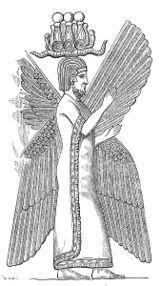
- Achaemenes
- Teispes (r. c. 675-625 BC)
- Cyrus I (r. c. 625-580)
- Cambyses I (r. c. 580-559)
- Cyrus II the Great (r. 559-530)
- Darius I the Great (r. 522-486)
- Xerxes I (r. 486-465)
- Artaxerxes I (r. 465–424)
- Darius II (r. 423–404)
- Artaxerxes II (r. 404-358)
Rhodogoune, daughter of Artaxerxes II, married Orontes I, and it is through their son Orontes II that said kings of Persia are genealogically linked to Elizabeth Vane:
Descent of Elizabeth Vane from Orontes I
- Orontes I
- Orontes II
- Mithrenes
- Orontes III
- Sames
- Arsames I
- Orontes IV
- Ptolemaeus
- Samses II
- Mithridates I
- Antiochus I
- Athenais[1]
- Darius II
- Vonones II
- Vologases I
- Pacorus II
- Mithridates V
- Vologases IV
- Vologases V
- Khosrov I
- Tiridates II
- Khosrov II
- Tiridates III
- Khosrov III
- Bambish
- St Nerses I
- St Sahak
- Sahankanoysh Pahlavi
- Hemayakes I
- Vahan Mamikonian
- Hemayakes II
- Mushegh II
- Vahan
- Dawith
- Hamazasp III
- Artavazd I
- Hemayakes III
- Artavazd II
- Marinos Mamikonian
- Theodora Mamikonian
- Emperor Michael III
- Emperor Leo VI
- Anna of Constantinople
- Charles-Constantine, Count of Vienne
- Constance of Vienne
- William I, Count of Provence
- William II, Count of Provence
- Geoffrey I, Count of Provence
- Stephanie of Provence
- Stephanie of Besalú
- Roger III, Count of Foix
- Roger-Bernard I, Count of Foix
- Rohese of Foix
- Hugh le Despencer
- Hugh, 1st Baron le Despencer
- Eleanor le Despencer
- Avelina de Courtenay
- John Giffard
- John Giffard
- Joan Giffard
- Richard Knightley MP
- Richard Knightley
- Richard Knightley
- Susan Knightley
- John Spencer
- William Spencer
- Catherine Spencer
- Lucy Montagu
- Alice Hare
- Catharine Fletcher
- Elizabeth Vane
Seleucids and Parthians
The Seleucid dynasty reigned as kings of Persia from 305-129 BC (as well as kings of Syria from 200-64 BC), but gradually lost control of Persia to the Parthian Arsacid dynasty, which reigned from 247 BC - AD 228.
As can be seen in the tree above, Darius II[1] of Media Atropatene (who also had Ptolemaic ancestry; see Egyptian) was a descendant of the following Seleucid kings:

- Seleucus I Nicator (r. 305-281 BC)
- Antiochus I Soter (r. 281-261)
- Antiochus II Theos (r. 261-246)
- Seleucus II Callinicus (r. 246-225)
- Antiochus III the Great (r. 223-187)
- Seleucus IV Philopator (r. 187-175)
- Antiochus IV Epiphanes (r. 175-164)
- Demetrius I Soter (r. 161-150)
- Demetrius II Nicator (r. 145-138, 129-125)
- Antiochus VIII Grypus (r. 125-96; reigned only over Syria, not Persia)
Darius II married a daughter of Phraates IV, meaning that their descendants were thereby also descended from the following patrilineal line of Parthian (Arsacid) kings:
- Priapatius (r. 191-176 BC)
- Mithridates I the Great (r. 165-132)
- Sinatruces (r. 75-69)
- Phraates III (r. 69-57)
- Orodes II (r. 57-37)
- Phraates IV (r. 37-2)
Darius and the daughter of Phraates had two sons, one of whom was Vonones II, who heads the following direct line of Parthian kings of Persia:
- Vonones II (r. AD 51)
- Vologases I (r. 51-78)
- Pacorus II (r. 78-110)
- Mithridates V (r. 129-140)
- Vologases IV (r. 147-191)
- Vologases V (r. 191-208)
Vologases V had four sons, only one of whom, Khosrov I - who succeeded him to the Armenian rather than the Persian throne - has been traced as a direct ancestor of Elizabeth Vane:
Descent of Elizabeth Vane from Vologases V
- Vologases V
- Khosrov I
- Tiridates II
- Khosrov II
- Tiridates III
- Khosrov III
- Bambish
- St Nerses I
- St Sahak
- Sahankanoysh Pahlavi
- Hemayakes I
- Vahan Mamikonian
- Hemayakes II
- Mushegh II
- Vahan
- Dawith
- Hamazasp III
- Artavazd I
- Hemayakes III
- Artavazd II
- Marinos Mamikonian
- Theodora Mamikonian
- Emperor Michael III
- Emperor Leo VI
- Anna of Constantinople
- Charles-Constantine, Count of Vienne
- Constance of Vienne
- William I, Count of Provence
- William II, Count of Provence
- Geoffrey I, Count of Provence
- Stephanie of Provence
- Stephanie of Besalú
- Roger III, Count of Foix
- Roger-Bernard I, Count of Foix
- Rohese of Foix
- Hugh le Despencer
- Hugh, 1st Baron le Despencer
- Eleanor le Despencer
- Avelina de Courtenay
- John Giffard
- John Giffard
- Joan Giffard
- Richard Knightley MP
- Richard Knightley
- Richard Knightley
- Susan Knightley
- John Spencer
- William Spencer
- Catherine Spencer
- Lucy Montagu
- Alice Hare
- Catharine Fletcher
- Elizabeth Vane
Diadochi (4th-3rd centuries BC)
The House of Austen is descended from five of the Diadochi ("successors"), that is, generals and friends of Alexander the Great who fought for and apportioned control over his many conquests after his death in 323 BC:

- Antipater (400-319 BC) was an advisor to Alexander's father Philip II, and ruled Alexander's European lands as regent during his absence on his great campaign east. After Alexander's death, Antipater became governor of Macedon, Greece and Epirus, and guardian of Alexander's nominal co-heirs (his disabled brother and infant child). Antipater was later the regent of the entire empire for a brief period from 321 until his death.
- Antigonus (382-301) was a leading general under both Philip II and Alexander, fighting in many of the greatest battles of the latter. Upon the partition of the empire, he became governor of Asia Minor and, for a time, took control of all the vast Asian provinces during wars with the various regents and other governors. In 306 he conquered Cyprus and assumed the title of king, declaring his realm independent from the nominal continuation of Alexander's united empire, but was killed in battle by other Diadochi opposed to his growing power. His descendants seized the throne of Macedon and ruled it until 168 BC.
- Lysimachus (360-281) was one of Alexander's seven bodyguards (somatophylakes), and became governor of Thrace at the partition of the empire. In 306 he assumed the title of king like Antigonus, and later took control of Macedon and Asia Minor before his death.
- Seleucus (358-281) was a leading general under Alexander, and became second-in-command to the first regent after Alexander's death. Seleucus was later appointed governor of Babylon, and in the various wars between the Diadochi eventually established control over the bulk of Alexander's Asian conquests.
- Ptolemy (367-282) was another of the somatophylakes. After Alexander's death, Ptolemy became governor and later king of Egypt, and was the diadochus who acquired and entombed Alexander's body.
For the descent of the Austens from Seleucus, see above, and from Ptolemy, see below. The following establishes the descent of the House of Austen from Antipater, Antigonus, and Lysimachus:
As can be seen in the tree above, the two daughters of Antipater were wife and daughter-in-law to Lysimachus and Antigonus, respectively. Their descendants, Ptolemy III and Berenice II (second cousins once removed) married, and Elizabeth Vane is a direct descendant of their son Ptolemy IV:
Descent of Elizabeth Vane from Ptolemy IV
- Ptolemy IV Philopator
- Ptolemy V Epiphanes
- Ptolemy VIII Physcon
- Tryphaena
- Laodice VII
- Antiochus I
- Athenais[1]
- Darius II
- Vonones II
- Vologases I
- Pacorus II
- Mithridates V
- Vologases IV
- Vologases V
- Khosrov I
- Tiridates II
- Khosrov II
- Tiridates III
- Khosrov III
- Bambish
- St Nerses I
- St Sahak
- Sahankanoysh Pahlavi
- Hemayakes I
- Vahan Mamikonian
- Hemayakes II
- Mushegh II
- Vahan
- Dawith
- Hamazasp III
- Artavazd I
- Hemayakes III
- Artavazd II
- Marinos Mamikonian
- Theodora Mamikonian
- Emperor Michael III
- Emperor Leo VI
- Anna of Constantinople
- Charles-Constantine, Count of Vienne
- Constance of Vienne
- William I, Count of Provence
- William II, Count of Provence
- Geoffrey I, Count of Provence
- Stephanie of Provence
- Stephanie of Besalú
- Roger III, Count of Foix
- Roger-Bernard I, Count of Foix
- Rohese of Foix
- Hugh le Despencer
- Hugh, 1st Baron le Despencer
- Eleanor le Despencer
- Avelina de Courtenay
- John Giffard
- John Giffard
- Joan Giffard
- Richard Knightley MP
- Richard Knightley
- Richard Knightley
- Susan Knightley
- John Spencer
- William Spencer
- Catherine Spencer
- Lucy Montagu
- Alice Hare
- Catharine Fletcher
- Elizabeth Vane
Egyptian (7th-2nd centuries BC)
The House of Austen is descended from two ruling dynasties of ancient Egypt: the Twenty-seventh Dynasty and the Ptolemaic Dynasty. The Twenty-seventh Dynasty of Egypt were the Achaemenids, who for some time ruled over Egypt as well as Persia. The Achaemenids who reigned as Pharaoh from whom Elizabeth Vane is descended were Darius I the Great (r. 522-486 BC), Xerxes I (r. 486-465), Artaxerxes I, (r. 465–424) Darius II (r. 423–404), and Artaxerxes II (r. 404-401); see above for the details of her descent from them.
The second Egyptian dynasty from which the House of Austen is descended, the Ptolemies (sometimes considered the Thirty-third dynasty), ruled as Pharaohs from 305-30 BC.
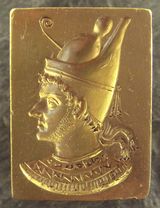
As can be seen in the tree above, Laodice VII was a descendant of the following Pharaohs:
- Ptolemy I Soter (r. 305-282 BC)
- Ptolemy II Philadelphus (r. 305-282)
- Ptolemy III Euergetes (r. 246-222)
- Ptolemy IV Philopator (r. 222-204)
- Ptolemy V Epiphanes (r. 204-180)
- Ptolemy VI Philometor (r. 180-164, 163-145)
- Ptolemy VIII Physcon (r. 169-163, 144-131, 126-116)
Laodice VII married Mithridates I Callinicus, and it is through their son Antiochus I that the Ptolemies are genealogically linked to Elizabeth Vane:
Descent of Elizabeth Vane from Laodice VII
- Laodice VII
- Antiochus I
- Athenais[1]
- Darius II
- Vonones II
- Vologases I
- Pacorus II
- Mithridates V
- Vologases IV
- Vologases V
- Khosrov I
- Tiridates II
- Khosrov II
- Tiridates III
- Khosrov III
- Bambish
- St Nerses I
- St Sahak
- Sahankanoysh Pahlavi
- Hemayakes I
- Vahan Mamikonian
- Hemayakes II
- Mushegh II
- Vahan
- Dawith
- Hamazasp III
- Artavazd I
- Hemayakes III
- Artavazd II
- Marinos Mamikonian
- Theodora Mamikonian
- Emperor Michael III
- Emperor Leo VI
- Anna of Constantinople
- Charles-Constantine, Count of Vienne
- Constance of Vienne
- William I, Count of Provence
- William II, Count of Provence
- Geoffrey I, Count of Provence
- Stephanie of Provence
- Stephanie of Besalú
- Roger III, Count of Foix
- Roger-Bernard I, Count of Foix
- Rohese of Foix
- Hugh le Despencer
- Hugh, 1st Baron le Despencer
- Eleanor le Despencer
- Avelina de Courtenay
- John Giffard
- John Giffard
- Joan Giffard
- Richard Knightley MP
- Richard Knightley
- Richard Knightley
- Susan Knightley
- John Spencer
- William Spencer
- Catherine Spencer
- Lucy Montagu
- Alice Hare
- Catharine Fletcher
- Elizabeth Vane
Under some historical theories, it is also possible that the House of Austen may be able to trace descent from the Hyksos Fifteenth Dynasty of Egypt. This theory is explained below:
Hyksos Theory
Under this theory, the House of Austen would be able to trace its descent from Khyan and his grandson Apepi.
The Hyksos Theory requires the adoption of the principles of the "New Chronology" developed by David Rohl et al. The New Chronology revises the established chronology of Egypt prior to Persian rule - which was based primarily upon Manetho, biblical synchronisms suggested by early 19th century Egyptologists, and the now mostly discredited system of Sothic dating - by proposing a greater degree of overlap than commonly accepted between various co-ruling dynasties during the poorly documented and chaotic Third Intermediate Period, having it start in the mid ninth century BC rather than the early eleventh century and therefore bringing forward the dates of the New Kingdom and prior dynasties by two to three centuries. Although this theory enables Rohl (and other historians such as Peter James) to put forward compelling solutions to various otherwise seemingly unsolvable problems and apparent mysteries in the archaeology and chronology of Egypt and the ancient Eastern Mediterranean, the New Chronology has not yet been adopted by most mainstream Egyptologists.
The Hyksos were expelled from Egypt by Ahmose I, with Egyptian histories recording that the embattled Hyksos forces were allowed to escape rather than being destroyed. In Rohl's work The Lords of Avaris (2007), he proposes that the Greek myth of Danaus - who was expelled from Egypt by his brother - is a legendary retelling of the expulsion of the Hyksos. Adopting the New Chronology, the date of the Hyksos Fifteenth Dynasty is reduced from the 17th-16th centuries BC to the 13th, allowing synchronisation with the time period in which the Greek myth of Danaus is based.
Under this model, Inachus is identified with the Hyksos pharaoh Khyan, who Rohl argues ruled a maritime empire originally based in the Peloponnese before his move to the Nile Delta, dominating the coasts and islands of the eastern Mediterranean. Khyan's Horus name, variously reconstructed as Inek-tau or Anak-idbu, ("uniter of the shores", "embracer of the coastlands", or "lord of the islands"), refers to this maritime dominance and was remembered in Greek as "Inachus", who was revered as a son of Oceanus.
Inachus' daughter Io is then identified as Ahhotep (although most Egyptologists assume Ahhotep's father was Senakhtenre, this is an unfounded assumption, as contemporary evidence only states she is daughter of a king without specifying which one). In Greek mythology, Io travels from Greece to Egypt, where she bears a son from Zeus, Epaphus, and ends up marrying a king Telegonus. Epaphus is identified with Apepi (known in other Greek sources, e.g. by Manetho, as "Apophis"). As for Io marrying Telegonus the king of Egypt, it is known that diplomatic marriages did take place between the Hyksos Fifteenth Dynasty and the rival (and likely sometime vassal) Theban Seventeenth Dynasty; Rohl therefore proposes that the Greek myth remembers the marriage of Ahhotep to Seqenenre Tao ("Telegonus" being a garbled derivative of the name Tao-qen, "Tao the Brave", a popular but "unofficial" variant confirmed to exist from evidence found in tomb QV47, which belonged to his daughter). This would make Ahmose I the step-brother of Apepi, providing further context for the myth of Danaus' expulsion from Egypt by his brother. More evidence for a familial link comes from the prefix "Iah", referring to an Egyptian moon goddess (usually transliterated "Ah-"), being found in the names of not only Ahhotep and her son Ahmose, but also in that of her brother (in this theory), Yanassi (Io had lunar associations in the Greek myths, as well).
Danaus is said to have had a cousin, Cadmus, who Rohl identifies with the final Hyksos pharaoh Khamudi, making Danaus a Hyksos royal contemporary with the expulsion but not a pharaoh himself. In Greek myth, Danaus is a great-grandson of Epaphus (Apepi), which is very difficult to reconcile chronologically with the historical records of the Hyksos. However, the two figures in the intervening generations are more obviously mythical in character, namely Libya (a personification of the country) and Belus (a figure often theorised to be derived from the storm-god Ba'al Hadad, the Phoenician understanding of the Hyksos patron Seth). Chronologically speaking, it is far more likely that Danaus and Cadmus/Khamudi were grandchildren rather than great-grandchildren of Epaphus/Apepi.
Danaus, according to ancient Greek heroic pedigrees, was the great-x11 grandfather of Karanos of Macedon, who is an ancestor of the House of Austen on somewhat more solidly documented grounds as detailed above. Assuming adoption of Rohl's New Chronology, therefore, Karanos has in his ancestry two Hyksos Pharaohs of the Fifteenth Dynasty via the following line of descent:
- Khyan Inek-tau/Inachus (r. c. 1261-1240 BC)
- Ahhotep/Io
- Apepi/Epaphus (r. c. 1230-1200)
- "Libya"
- Danaus
- Hypermnestra
- Abas
- Acrisius
- Danaë
- Perseus
- Electryon
- Alcmene
- Heracles
- Hyllus
- Cleodaeus
- Aristomachos
- Temenos
- Karanos
Armenian (2nd century BC - 4th century AD)
The House of Austen is descended from three dynasties of Armenian kings: the Orontids (321 - 200 BC), Artaxiads (189 BC - AD 12), and Arsacids (52 - 428 AD). The lines of descent of these dynasties to the House of Austen are as follows:
Artaxiad
- Artaxias I (r. 189-160 BC)
- Tigranes I (r. 115-95)
- Tigranes II the Great (r. 95-55)
Tigranes the Great had a daughter who married Mithridates I of Media Atropatene. The grandson of this couple, Artavasdes I, is an ancestor of the Arsacid line as detailed below.

Orontids and Arsacids
- Orontes III (r. 321-260 BC)
- Sames (r. 260)
- Arsames I (r. 260-228)
- Orontes IV (r. 212-200)
- Ptolemaeus (r. 163-130; reigned only over Commagene)
- Sames II Theosebes Dikaios (r. 130-109; reigned only over Commagene)
- Mithridates I Callinicus (r. 109-70; reigned only over Commagene)
- Antiochus I Theos (r. 70-38; reigned only over Commagene)
Antiochus I Theos's daughter married Artavasdes I of Media Atropatene. Their son, Darius II,[1] was the direct ancestor of Vologases II (V of Persia), who established the Arsacid dynasty of Armenia as the hereditary kings of that country.
- Darius II
- Vonones II of Parthia
- Vologases I of Parthia
- Pacorus II of Parthia
- Mithridates V of Parthia
- Vologases IV of Parthia
- Vologases II (r. AD 186-198)
- Khosrov I (r. 198-217)
- Tiridates II (r. 217-252)
- Khosrov II (r. 252)
- Tiridates III (r. 287-330)
- Khosrov III Kotak (r. 330-339)
Khosrov III had a daughter, Bambish, who married At’anaganes, the great-grandson of Saint Gregory the Illuminator. Bambish and At'anaganes were parents of Catholicos Nerses I, through whom therefore the Artaxiads, Orontids, and Arsacids are ancestors of Elizabeth Vane:
Descent of Elizabeth Vane from Nerses I
- St Nerses I
- St Sahak
- Sahankanoysh Pahlavi
- Hemayakes I
- Vahan Mamikonian
- Hemayakes II
- Mushegh II
- Vahan
- Dawith
- Hamazasp III
- Artavazd I
- Hemayakes III
- Artavazd II
- Marinos Mamikonian
- Theodora Mamikonian
- Emperor Michael III
- Emperor Leo VI
- Anna of Constantinople
- Charles-Constantine, Count of Vienne
- Constance of Vienne
- William I, Count of Provence
- William II, Count of Provence
- Geoffrey I, Count of Provence
- Stephanie of Provence
- Stephanie of Besalú
- Roger III, Count of Foix
- Roger-Bernard I, Count of Foix
- Rohese of Foix
- Hugh le Despencer
- Hugh, 1st Baron le Despencer
- Eleanor le Despencer
- Avelina de Courtenay
- John Giffard
- John Giffard
- Joan Giffard
- Richard Knightley MP
- Richard Knightley
- Richard Knightley
- Susan Knightley
- John Spencer
- William Spencer
- Catherine Spencer
- Lucy Montagu
- Alice Hare
- Catharine Fletcher
- Elizabeth Vane
Roman (3rd-6th, 9th-13th centuries)
The House of Austen is directly descended from seventeen Roman Emperors, both classical and medieval.
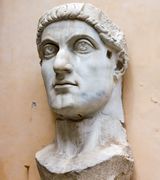
Classical
The House of Austen can document their direct descent from ten classical Roman Emperors, namely:
Tetrarchy and Constantinian dynasty:
- Maximian (r. AD 286-305, 306-308)
- Constantius I (r. 305-306)
- St Constantine I the Great (r. 307-337)
Valentinian dynasty and Theodosian dynasty:
- Valentinian I the Great (r. 364-375)
- St Theodosius I the Great (r. 379-395)
- Arcadius (r. 383-408)
- St Theodosius II (r. 402-450)
- Constantius III (r. 421)
- Valentinian III (r. 425-455)
- Olybrius (r. 472)
As seen in the tree above, the aforementioned ten classical emperors all share one Areobindus (b. c. 550) as a descendant. Said Areobindus is a direct ancestor of Elizabeth Vane:
Descent of Elizabeth Vane from Areobindus
- Areobindus
- Anastasia Areobinda
- Flavia Juliana
- Ardabastos
- Erwig
- Peter
- Fruela Pérez
- Bermudo I
- Ramiro I
- Ordoño I
- Leodegundia Ordoñez
- Onecca
- Mumadona Díaz
- Gonzalo Menéndez
- Ramíro Gonzalez
- Ordoño Ramírez
- Muniadona Ordóñez
- Cristina Fernández
- Jimena Díaz
- María Rodríguez de Vivar
- Jimena de Barcelona
- Roger-Bernard I, Count of Foix
- Rohese of Foix
- Hugh le Despencer
- Hugh, 1st Baron le Despencer
- Eleanor le Despencer
- Avelina de Courtenay
- John Giffard
- John Giffard
- Joan Giffard
- Richard Knightley MP
- Richard Knightley
- Richard Knightley
- Susan Knightley
- John Spencer
- William Spencer
- Catherine Spencer
- Lucy Montagu
- Alice Hare
- Catharine Fletcher
- Elizabeth Vane
As seen in the Imperial Roman family tree above, Areobindus can also claim descent from the siblings of Roman Emperors. His paternal grandfather, Flavius Anastasius (consul 517), was the great-nephew of the emperor Anastasius I (r. 491-518). Furthermore, Areobindus's daughter, Anastasia Areobinda, married the curopalates Peter, brother to the emperor Maurice (r. 582-602), the latter of whom was therefore uncle to Anastasia's daughter Flavia Juliana.
The tree also includes the claim that the mother of Constantius I was Claudia, a niece of the emperors Claudius II Gothicus (r. 268-270) and Quintillus (r. 270), which would make a sibling of two more emperors a direct ancestor of the House of Austen. However, it is important to note that this claim regarding the ancestry of Constantius I is known only from sources recorded after his death, and some historians believe it was a claim made after the collapse of Diocletian's Tetrarchy to legitimize the Constantinian dynasty on a hereditary basis by connecting it with two popular pre-Tetrarchic emperors.
Another possible emperor's sibling from whom the House of Austen is descended is the daughter of Julius Agricola (not included in the above tree; fl. 421). Agricola was a relative of the emperor Avitus (r. 455-456), and most likely his father, but this has never been proven. If it were the case, however, then the daughter of Agricola would be sister to Avitus; her son, Flavius Magnus (fl. 460s), is a direct ancestor of Elizabeth Vane:
Descent of Elizabeth Vane from Flavius Magnus
- Flavius Magnus
- Flavius Probus
- Industria Narbo
- Ferreolus Rodez
- Ansbertus
- Arnoald
- Doda
- Ansegisel
- Pepin II
- Charles Martel
- Carloman
- Rotrude
- Beggo de Paris
- Engletrude de Paris
- Eberhard de Friuli
- Berengar I
- Gisela de Friuli
- Berengar II
- Adalbert II
- Otto-William, Count of Burgundy
- Gerberga de Burgundy
- Geoffrey I, Count of Provence
- Stephanie of Provence
- Stephanie of Besalú
- Roger III, Count of Foix
- Roger-Bernard I, Count of Foix
- Rohese of Foix
- Hugh le Despencer
- Hugh, 1st Baron le Despencer
- Eleanor le Despencer
- Avelina de Courtenay
- John Giffard
- John Giffard
- Joan Giffard
- Richard Knightley MP
- Richard Knightley
- Richard Knightley
- Susan Knightley
- John Spencer
- William Spencer
- Catherine Spencer
- Lucy Montagu
- Alice Hare
- Catharine Fletcher
- Elizabeth Vane
Finally, there is a possibility that the House of Austen may be able to trace descent from the very first Roman Emperor, according to research conducted by French historian and genealogist Christian Settipani:
Augustus Theory
The following line of descent links Augustus (r. 27 BC - AD 14), the first Roman Emperor, to Charlemagne; for the House of Austen's descent from Charlemagne, see below.
It is important to note that Christian Settipani, the genealogist who constructed this line of descent, does not argue that it is necessarily factually true, but rather that it is historically plausible. In the line of descent reproduced below, the four links in italics are those theorised by Settipani to fill the gap between the two otherwise historically documented lines of the descendants of Augustus and the ancestors of Charlemagne. While the four theorised links are plausible - and indeed probable - they have not yet been confirmed with documentary evidence, although they nevertheless provide a likely route of descent:
- Augustus
- Julia the Elder
- Julia Minor
- Aemilia Lepida
- Junia Lepida
- Cassius Lepidus
- Cassia Lepida
- Julia Cassia Alexandra
- Avidius Cassius
- Avidia Cassia Alexandra
- Claudia Vettia Agrippina
- Claudia
- Claudia Capitolina
- Amnia Demetrias
- Amnius Anicius Julianus
- Amnius Anicius Paulinus
- Anicius Auchenius Bassus
- Turrenia Anicia Iuliana
- Anicia
- Adelfius I
- Leontia
- St Ruricius
- daughter of St Ruricius
- Artemia
- Arthemia
- Mummolin
- Bodegisel
- St Arnulf
- Ansegisel
- Pepin II
- Charles Martel
- Pepin
- Charlemagne
Medieval
Austen descent can also be traced from various dynasties of the ("Byzantine") medieval Roman Emperors. Of the Amorian (Phrygian) and Macedonian dynasties, descent can be traced from the following four in a father-son succession:
- Michael II (r. 820-829)
- Theophilos (r. 822-842)
- Michael III (r. 840-867)
- Leo VI[2] (r. 870-912)
Anna, a daughter of Leo VI, was the mother[3] of Charles-Constantine of Vienne, who is a direct ancestor of Elizabeth Vane:
Descent of Elizabeth Vane from Charles-Constantine of Vienne
- Charles-Constantine, Count of Vienne
- Constance of Vienne
- William I, Count of Provence
- William II, Count of Provence
- Geoffrey I, Count of Provence
- Stephanie of Provence
- Stephanie of Besalú
- Roger III, Count of Foix
- Roger-Bernard I, Count of Foix
- Rohese of Foix
- Hugh le Despencer
- Hugh, 1st Baron le Despencer
- Eleanor le Despencer
- Avelina de Courtenay
- John Giffard
- John Giffard
- Joan Giffard
- Richard Knightley MP
- Richard Knightley
- Richard Knightley
- Susan Knightley
- John Spencer
- William Spencer
- Catherine Spencer
- Lucy Montagu
- Alice Hare
- Catharine Fletcher
- Elizabeth Vane
The mother of Leo VI, Eudokia Ingerina, is descended from the sibling of another emperor: Maria, sister of Heraclius (r. 610-641). Eudokia's mother was the daughter of one Inger Martinakios, son of Anastasios, son of Theophylactos, son of Martinakes, son of Martinos, son of Andreas. Andreas had as his paternal grandparents Martinus and Maria, the latter of whom was sister of Heraclius. As well as Andreas' father, Martinus and Maria had a daughter, Martina, who married her uncle Heraclius; Andreas' father (Maria's son and Eudokia's great-x6 grandfather) was therefore not only the nephew of said emperor but also his brother-in-law.
Direct descent from three more emperors - Alexios I (r. 1081-1118), Alexios III (r. 1195-1203), and Theodore I (r. 1205-1221), of the Komnenos, Angelos, and Laskaris dynasties respectively - can be traced from Maria Laskarina, whose father was Theodore I and whose maternal grandfather was Alexios III, the latter of whom himself had Alexios I as a great-grandfather. A further connection - albeit not direct descent - can be traced to Constantine X (r. 1059-1067) of the Doukas dynasty, who was great-granduncle of Theodora Komnene, the maternal grandmother of Alexios III. The afore-mentioned Maria Laskarina is a direct ancestor of Elizabeth Vane:
Descent of Elizabeth Vane from Maria Laskarina
- Maria Laskarina
- Stephen V
- Mary Árpád
- Margaret of Anjou
- Joan of Valois
- Philippa of Hainault
- John of Gaunt
- Joan Beaufort
- Edward Neville
- Margaret Neville
- Thomas Brooke
- Elizabeth Brooke
- Sir Thomas Wyatt
- Anne Wyatt
- Margaret Twysden
- Sir Henry Vane
- Sir George Vane
- Lionel Vane
- Elizabeth Vane
French (5th-6th, 8th-10th centuries)
The House of Austen is descended from the Merovingian, Carolingian and Robertian dynasties of what is today France.
Merovingians
The first known Merovingian king was Childeric I, who reigned over the Salian Franks from AD 458-481. He was succeeded as King of the Salian Franks by his son, Clovis I, who converted to Christianity, conquered most of Gaul, and united the Franks into a single kingdom c. 509 which he reigned over until his death in 511. The Merovingians treated their kingdom as single yet divisible, and Clovis' four sons divided the kingdom between them. It was briefly reunited between 558-561 under his son Clothar I, who had inherited from Clovis the Kingdom of Soissons, but otherwise remained mostly divided until the late 7th century. One of Clothar's sons, Sigebert I, reigned over one of these divisions as King of Austrasia from 561-575, and it is from his daughter and eldest child Ingund that Elizabeth Vane is descended:
Descent of Elizabeth Vane from Ingund the Merovingian
- Ingund
- Athanagild
- Ardabastos
- Erwig
- Peter
- Fruela Pérez
- Bermudo I
- Ramiro I
- Ordoño I
- Leodegundia Ordoñez
- Onecca
- Mumadona Díaz
- Gonzalo Menéndez
- Ramíro Gonzalez
- Ordoño Ramírez
- Muniadona Ordóñez
- Cristina Fernández
- Jimena Díaz
- María Rodríguez de Vivar
- Jimena de Barcelona
- Roger-Bernard I, Count of Foix
- Rohese of Foix
- Hugh le Despencer
- Hugh, 1st Baron le Despencer
- Eleanor le Despencer
- Avelina de Courtenay
- John Giffard
- John Giffard
- Joan Giffard
- Richard Knightley MP
- Richard Knightley
- Richard Knightley
- Susan Knightley
- John Spencer
- William Spencer
- Catherine Spencer
- Lucy Montagu
- Alice Hare
- Catharine Fletcher
- Elizabeth Vane
Carolingians and Robertians

The Carolingian dynasty served as the hereditary mayors of the palace under the later Merovingians, and therefore as the power behind the throne. They supplanted the Merovingians as Kings of the Franks in 751 with the support of the Papacy and the nobility. The House of Austen is descended from an unbroken patrilineal line of seven Carolingian kings (the first three Kings of the Franks, the remaining four Kings of West Francia), as follows:
- Pepin (r. 751-768)
- Charlemagne (r. 768-814)
- Louis I (r. 814-840)
- Charles II (r. 840-877)
- Louis II (r. 877-879)
- Charles III (r. 898-922)
- Louis IV (r. 936-954)
The House of Austen can trace various lines of descent from King Louis IV through his son, Charles, Duke of Lower Lorraine. The following line of descent is via the Counts of Louvain:
Descent of Elizabeth Vane from Charles, Duke of Lower Lorraine
- Charles
- Gerberga
- Lambert II de Lovain
- Henry II de Lovain
- Godfrey I de Lovain
- Godfrey II de Lovain
- Gofrey III de Lovain
- Godfrey de Lovaine
- Mathieu de Lovaine
- Hawise de Lovaine
- Aline Bassett
- Hugh, 1st Baron le Despencer
- Eleanor le Despencer
- Avelina de Courtenay
- John Giffard
- John Giffard
- Joan Giffard
- Richard Knightley MP
- Richard Knightley
- Richard Knightley
- Susan Knightley
- John Spencer
- William Spencer
- Catherine Spencer
- Lucy Montagu
- Alice Hare
- Catharine Fletcher
- Elizabeth Vane
The Austens are also descended from Robert I (r. 922-923), a member of the Robertian dynasty, through his daughter Adele:
Descent of Elizabeth Vane from Adele of France
- Adele
- Robert de Vermandois
- Adele de Vermandois
- Ermengarde-Gerberga de Anjou
- Judith de Rennes
- Richard III
- Alice de Normandy
- Ranulf de Briquessart
- Ranulf le Meschin
- Alice de Gernon
- Roger de Clare
- Aveline de Clare
- Hawise FitzGeoffrey
- Lucy de Mohun
- Henry de Grey
- Richard de Grey
- Jane de Grey
- Alilitha Harcourt
- Elizabeth DeBurgh
- Richard Knightley
- Richard Knightley MP
- Richard Knightley
- Richard Knightley
- Susan Knightley
- John Spencer
- William Spencer
- Catherine Spencer
- Lucy Montagu
- Alice Hare
- Catharine Fletcher
- Elizabeth Vane
Scottish (5th-11th centuries)
The House of Austen can trace its descent from the following patrilineal line of fourteen kings of Dál Riata:
- Eochaid Muinremuir (r. fl. 5th century)[4]
- Erc (r. c. 439-474)
- Fergus Mór (r. c. 498-501)
- Domangart Réti (r. c. 501-507)
- Gabrán mac Domangairt (r. fl. 6th century)
- Áedán mac Gabráin (r. c. 574-608)
- Eochaid Buide (r. 608-629)
- Domnall Brecc (r. 629-642)
- Domangart mac Domnaill (r. c. 660-673)
- Eochaid mac Domangairt (r. fl. 697)
- Eochaid mac Echdach (r. 726-733)
- Áed Find (r. fl. 8th century)
- Eochaid mac Áeda Find (r. fl. c. 8th-9th century)
- Alpín mac Echdach (r. c. 838-841)
Kenneth I, son of Alpín, took the throne of Dál Riata in 841 and conquered the kingdom of the Picts in 843, uniting both realms into what would become Scotland. His grandson Donald II was the first man to be called rí Alban, or King of Alba, which increasingly became known by its Latin name Scotia, and its rulers as the kings of Scots. The following six members of the House of Alpin continue the patrilineal line of descent:
- Kenneth I MacAlpin (r. 841-858)
- Constantine I (r. 862-877)
- Donald II (r. 889-900)
- Malcolm I (r. 943 - 954)
- Kenneth II (r. 971-995)
- Malcolm II (r. 1005-1034)
Malcolm II died with no sons, and the Scottish throne passed through his daughter, Bethóc, to her son Duncan I. Bethóc was therefore mother and grandmother respectively to two further kings of Scots from which the House of Austen is descended, of the House of Dunkeld:
- Duncan I (r. 1034-1040)
- Malcolm III (r. 1058-1093)
A daughter of Malcolm III, namely Matilda of Scotland, married into the English royal family, and it is from her that the House of Austen can trace its descent from the aforementioned Scottish monarchs:
Descent of Elizabeth Vane from Matilda of Scotland
- Matilda
- Matilda
- Henry II
- John
- Henry III
- Edward I
- Edward II
- Edward III
- John of Gaunt
- Joan Beaufort
- Edward Neville
- Margaret Neville
- Thomas Brooke
- Elizabeth Brooke
- Sir Thomas Wyatt
- Anne Wyatt
- Margaret Twysden
- Sir Henry Vane
- Sir George Vane
- Lionel Vane
- Elizabeth Vane
Visigoth (6th-7th centuries)
The House of Austen is descended from at least one, and quite probably three, kings of Visigothic Spain. The first two are Liuvigild and his probable great-great-grandson Erwig, the patrilineal succession of whom is reconstructed as follows:

- Liuvigild (r. 568-586)
- Saint Hermenegild
- Athanagild
- Ardabastos
- Erwig (r. 680-687)
King Erwig was in all likelihood the father of Peter of Cantabria. Although later medieval chroniclers are unanimous on this point, modern scholars have noted that more contemporary sources do not give his exact parentage, simply stating that Peter was descended from the family of Liuvigild. Erwig remains in all likelihood the father of Peter,[5] but even should this not be accepted, Peter remains a descendant of Luivigild, albeit one for whom the precise line of descent cannot be confirmed.
The third king of Visigothic Spain from whom the Austens can trace a line of descent is Athanagild (r. 554-567), not to be confused with Erwig's grandfather of the same name, as King Athanagild was maternal grandfather of St Hermenegild's wife Ingund.
Elizabeth Vane is descended from Peter of Cantabria thus:
Descent of Elizabeth Vane from Peter of Cantabria
- Peter
- Fruela Pérez
- Bermudo I
- Ramiro I
- Ordoño I
- Leodegundia Ordoñez
- Onecca
- Mumadona Díaz
- Gonzalo Menéndez
- Ramíro Gonzalez
- Ordoño Ramírez
- Muniadona Ordóñez
- Cristina Fernández
- Jimena Díaz
- María Rodríguez de Vivar
- Jimena de Barcelona
- Roger-Bernard I, Count of Foix
- Rohese of Foix
- Hugh le Despencer
- Hugh, 1st Baron le Despencer
- Eleanor le Despencer
- Avelina de Courtenay
- John Giffard
- John Giffard
- Joan Giffard
- Richard Knightley MP
- Richard Knightley
- Richard Knightley
- Susan Knightley
- John Spencer
- William Spencer
- Catherine Spencer
- Lucy Montagu
- Alice Hare
- Catharine Fletcher
- Elizabeth Vane
English (6th, 8th-14th centuries)
Anglo-Saxon
The House of Austen is descended from a patrilineal succession of fifteen members of the Cerdicingas (House of Wessex), including kings of Wessex, Kent, and early England.
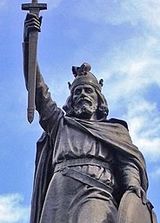
- Cerdic (r. 519-534; King of Wessex)
- Cynric (r. 534-560; King of Wessex)
- Ceawlin (r. 560-592; King of Wessex)
- Cuthwine
- Cuthwulf
- Ceolwald
- Cenred
- Ingild
- Eoppa
- Eafa
- Ealhmund (r. fl. 784; King of Kent)
- Ecgberht (r. 802-839; King of Wessex, also reigning as King of Kent from 825-839)
- Aethelwulf (r. 839-858; King of Wessex and of Kent)
- Alfred the Great (r. 871-899; King of Wessex, also reigning as King of the Anglo-Saxons from 886-899)
- Edward the Elder (r. 899-924; King of the Anglo-Saxons)
- Edmund I (r. 939-946; King of the English)
- Edgar the Peaceable (r. 959-975; King of the English)
- Æthelred the Unready (r. 978-1013, 1014-1016; King of the English)
- Edmund II Ironside (r. 1016; King of the English)
King Edmund II was the father of Edward the Exile, father to the maternal grandmother of the Empress Matilda (see below).
The House of Austen can also claim direct descent from Harold II Godwinson (r. 1066), the final Anglo-Saxon king of England, through his daughter Gytha:
Descent of Elizabeth Vane from Harold II
- Harold II
- Gytha
- Mstislav I
- Euphrosyne
- Béla III
- Andrew II
- Béla IV
- Stephen V
- Mary Árpád
- Margaret of Anjou
- Joan of Valois
- Philippa of Hainault
- John of Gaunt
- Joan Beaufort
- Edward Neville
- Margaret Neville
- Thomas Brooke
- Elizabeth Brooke
- Sir Thomas Wyatt
- Anne Wyatt
- Margaret Twysden
- Sir Henry Vane
- Sir George Vane
- Lionel Vane
- Elizabeth Vane
Norman and Plantagenet
The House of Austen is further descended from three of the Norman monarchs of England, namely William I (r. 1066-1087), his son Henry I (r. 1100-1135), and the latter's daughter the Empress Matilda (r. de facto 1141). Matilda was mother of King Henry II, who heads a patrilineal succession of six Plantagenet kings of England:
- Henry II (r. 1154–1189)
- John (r. 1199-1216)
- Henry III (r. 1216-1272)
- Edward I (r. 1272-1307)
- Edward II (r. 1307-1327)
- Edward III (r. 1327-1377)
King Edward III is a direct ancestor of Elizabeth Vane through his son John of Gaunt:
Descent of Elizabeth Vane from Edward III
- Edward III
- John of Gaunt
- Joan Beaufort
- Edward Neville
- Margaret Neville
- Thomas Brooke
- Elizabeth Brooke
- Sir Thomas Wyatt
- Anne Wyatt
- Margaret Twysden
- Sir Henry Vane
- Sir George Vane
- Lionel Vane
- Elizabeth Vane
Welsh (7th-13th centuries)
The House of Austen is descended from a total of twenty seven Welsh kings and princes. The most recent of these rulers is Llywelyn "the Great" ap Iorwerth - who reigned as Prince of Gwynedd (1195-1240), Prince of Powys Wenwynwyn (1216-40), and Prince of Wales (1228-40) - who is a direct descendant of the other twenty six monarchs.
Elizabeth Vane is descended from Prince Llywelyn through his daughter, Gwladus Ddu ferch Llywelyn:

Descent of Elizabeth Vane from Gwladus Ddu
- Gwladus Ddu
- Roger Mortimer
- Edmund Mortimer
- Roger Mortimer
- Joan Mortimer
- Joan Audley
- John Tuchet
- John Tuchet
- James Tuchet
- Elizabeth Tuchet
- John Brooke
- Thomas Brooke
- Elizabeth Brooke
- Sir Thomas Wyatt
- Anne Wyatt
- Margaret Twysden
- Sir Henry Vane
- Sir George Vane
- Lionel Vane
- Elizabeth Vane
Llywelyn the Great is the last in a patrilineal line of Kings of Gwynedd, those of whom from which he was descended also bore the title King of the Britons or King of Wales. The following line ends in Llyweylyn's father, Iorwerth Drwyndwn, who was not himself a reigning monarch:
- Merfyn Frych ap Gwriad (r. 825-844)
- Rhodri "the Great" ap Merfyn (r. 844-877; also reigned as King of Powys, 856-877)
- Anarawd ap Rhodri (r. 878-916)
- Idwal Foel ap Anarawd (r. 916-942)
- Meurig ap Idwal
- Idwal ap Meurig
- Iago ap Idwal (r. 1023-1039; also reigned as King of Powys)
- Cynan ab Iago
- Gruffudd ap Cynan (r. 1081-1137)
- Owain Gwynedd ap Gruffud (r. 1137-1170)
- Iorwerth Drwyndwn ap Owain
Iorweth Drwyndwn is descended from three more Welsh monarchs in the female line. Merfyn Frych, the most senior patrilineal ancestor in the above line, had as his maternal grandfather Cynan Dindaethwy ap Rhodri, who reigned both as King of the Britons and as King of Gwynedd from 798-816; the father of Cynan Dindaethwy was Rhodri Molwynog ap Idwal, who held the same thrones from c. 712-754. Likewise, the maternal grandfather of Anarawd ap Rhodri, also in the above patrilineal line, was Meurig, who reigned as King of Seisyllwg at some point in the mid-9th century.
Llywelyn the Great was descended from his other ruling ancestors through his mother, Marared ferch Madog. The earliest Welsh monarchs from whom she is descended are a patrilineal line of the Kings of Dyfed, starting in the 7th century:
- Cloten (r. fl. 7th century)
- Caten ap Cloten (r. fl. 7th century)
- Cadwgan ap Caten (r. fl. c. 7th-8th century)
- Rhain ap Cadwgan (r. fl. 8th century)
- Tewdws ap Rhain (r. c. 740)
- Maredudd ap Tewdws (r. c. 740-797)
- Owain ap Maredudd (r. c. 808-810)
Tangwystl ferch Owain, daughter of Owain ap Maredudd, married one Bleddri, and their son was Hyfaidd ap Bleddri, who reigned as King of Dyfed in the late 9th century. His son was Llywarch ap Hyfaidd, who succeeded him as King of Dyfed and reigned c. 893-904. Llywarch's daughter, Elen, married Cadell ap Rhodri, who heads another patrilineal line of descent:
- Cadell ap Rhodri[6] reigned as King of Seisyllwg from 872-909. He also conquered Dyfed from Llywarch ap Hyfaidd, although he did not take the throne of the kingdom but effectively annexed it to Seisyllwg.
- Hywel Dda ap Cadell took the throne of Seisyllwg in 909, formally merging the kingdom with the occupied Dyfed in 920 to form the new realm of Deheubarth, of which he was crowned King. In 942 he also took the throne of Gwynedd, after which he also reigned as King of the Britons. He continued to reign as King of the Britons and as King of both Deheubarth and Gwynedd until his death in 950.
- Owain ap Hywel Dda inherited the throne of Deheubarth from his father in 950, and reigned as such until his own death in 988.
- Maredudd ap Owain became King of Gwynedd in 986, reconquering the kingdom for his family after it was lost at the death of Hywel Dda. Two years later, in 988, he also became King of Deheubarth upon the death of his father, ruling both kingdoms and also assuming the title King of the Britons. He held power until his death in 999.
Maredudd's daughter, Angharad, had a son named Bleddyn ap Cynfyn who became both King of Powys and King of Gwynedd with Saxon support in 1063, and reigned until his death in 1075. None of his sons were old enough to succeed him, but one of his sons, Maredudd ap Bleddyn, did eventually reign over Powys (by this point the title of Prince was used more than that of King) from 1116 until his death in 1132, and was succeeded as Prince of Powys by his own son Madog ap Maredudd (r. 1132-1160). Prince Madog was the maternal grandather of Llywelyn the Great.
Holy Roman (9th-10th centuries)

The House of Austen is descended from nine Holy Roman Emperors, namely:
- Charlemagne (r. 800-814)
- Louis I (r. 813-840)
- Lothair I (r. 817-855)
- Louis II (r. 844-875)
- Charles II (r. 875-877)
- Louis III (r. 901-905)
- Berengar I (r. 915-924)
- Otto I "the Great" (r. 962-973)
- Otto II (r. 973-983)
As seen in the tree above, the first seven of the aforementioned nine emperors all share Eleanor le Despenser (1262-1328) as a descendant. Eleanor is a direct ancestor of Elizabeth Vane:
Descent of Elizabeth Vane from Eleanor le Despencer
- Eleanor le Despencer
- Avelina de Courtenay
- John Giffard
- John Giffard
- Joan Giffard
- Richard Knightley MP
- Richard Knightley
- Richard Knightley
- Susan Knightley
- John Spencer
- William Spencer
- Catherine Spencer
- Lucy Montagu
- Alice Hare
- Catharine Fletcher
- Elizabeth Vane
Furthermore, the latter two of the nine said emperors - Otto I and Otto II - were father and son, with Otto II's daughter Matilda an ancestor of Elizabeth Vane thus:
Descent of Elizabeth Vane from Matilda of Germany, Countess Palatine of Lotharingia
- Matilda of Germany
- Richeza Ezzonen
- Richeza Piast
- Géza I
- Álmos
- Béla II
- Géza II
- Béla III
- Andrew II
- Béla IV
- Stephen V
- Mary Árpád
- Margaret of Anjou
- Joan of Valois
- Philippa of Hainault
- John of Gaunt
- Joan Beaufort
- Edward Neville
- Margaret Neville
- Thomas Brooke
- Elizabeth Brooke
- Sir Thomas Wyatt
- Anne Wyatt
- Margaret Twysden
- Sir Henry Vane
- Sir George Vane
- Lionel Vane
- Elizabeth Vane
Polish (9th-11th centuries)
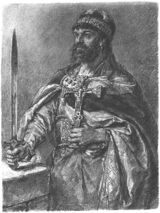
The House of Austen is descended from a patrilineal succession of seven ruling members of the House of Piast, the first royal family of medieval Poland:
- Piast the Wheelwright, r. fl. 9th century as Duke of the Polans
- Siemowit, r. fl. 9th century as Duke of the Polans
- Lestek, r. fl. early 10th century as Duke of the Polans
- Siemomysł, r. c. 930-960 as Duke of the Polans
- Mieszko I, r. c. 960-992 as Duke of Poland
- Bolesław I, r. 992-1025 as Duke of Poland and 1025 as King of Poland
- Mieszko II Lambert, r. 1025-1034 as King of Poland
King Mieszko II is a direct ancestor of Elizabeth Vane through his daughter, Richeza:
Descent of Elizabeth Vane from Richeza of Poland
- Richeza Piast
- Géza I
- Álmos
- Béla II
- Géza II
- Béla III
- Andrew II
- Béla IV
- Stephen V
- Mary Árpád
- Margaret of Anjou
- Joan of Valois
- Philippa of Hainault
- John of Gaunt
- Joan Beaufort
- Edward Neville
- Margaret Neville
- Thomas Brooke
- Elizabeth Brooke
- Sir Thomas Wyatt
- Anne Wyatt
- Margaret Twysden
- Sir Henry Vane
- Sir George Vane
- Lionel Vane
- Elizabeth Vane
Hungarian (9th-13th centuries)
The House of Austen is descended from a patrilineal succession of fifteen members of the House of Árpád, the ruling house of medieval Hungary. Those monarchs who ruled prior to the year 1000 were styled Grand Prince of the Hungarians, whereas those who ruled after 1000 were Kings of Hungary.
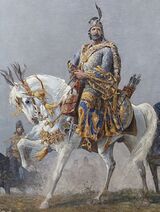
- Álmos (r. c. 850-895)
- Árpád (r. c. 895-907)
- Zoltán (r. c. 907-950)
- Taksony (r. c. 950-970)
- Michael
- Vazul
- Béla I (r. 1060-1063)
- Géza I (r. 1074-1077)
- Álmos
- Béla II (r. 1131-1141)
- Géza II (r. 1141-1162)
- Béla III (r. 1171-1196)
- Andrew II (r. 1205-1235)
- Béla IV (r. 1235-1270)
- Stephen V (r. 1270-1272)
King Stephen V of the Árpád dynasty was the father of Mary of Hungary, from whom Elizabeth Vane is descended thus:
Descent of Elizabeth Vane from Mary of Hungary
- Mary Árpád
- Margaret of Anjou
- Joan of Valois
- Philippa of Hainault
- John of Gaunt
- Joan Beaufort
- Edward Neville
- Margaret Neville
- Thomas Brooke
- Elizabeth Brooke
- Sir Thomas Wyatt
- Anne Wyatt
- Margaret Twysden
- Sir Henry Vane
- Sir George Vane
- Lionel Vane
- Elizabeth Vane
Notes
- ↑ 1.0 1.1 1.2 1.3 1.4 1.5 "Athenais" and "Darius II" are hypothetical names assigned to otherwise anonymous figures. French historian and genealogist Christian Settipani argues on the basis of information found in the works of Ancient Greek historian and geographer Strabo "that Vonones II, king of Media Atropatene, then of Parthia was linked through his anonymous father, possibly a "Darius", to a marriage between the Median king Artavasdes and the daughter of Antiochus I, king of Commagene". The name "Darius II" was put forward by Settipani as a hypothetical name for Vonones' father (although he now no longer makes use of this suggestion), and "Athenais" originated from a coin mistakenly attributed to the wife of Antiochus' son-in-law Artavasdes I by an anonymous Wikipedia editor. Both names have become widespread in various genealogies due to having been left on Wikipedia articles for several years, but are unlikely to have been those actually held by the individuals in question.[1]
- ↑ Officially, Leo VI was the son of Basil I, the successor of Michael III. However, it is far more likely that his actual biological father was Michael III. Leo was born on 19 September 866 to Eudokia Ingerina. Michael had fallen in love with Ingerina in 855, but the disapproval of Theodora, his mother and then regent, led to him marrying Eudokia Dekapolitissa, who Theodora selected for him. Michael's marriage to Dekapolitissa was childless and primarily ceremonial, and he arranged for Ingerina to marry Basil - who at the time was his favourite courtier - in order to gain her access to the imperial court. With Theodora deposed from the regency later that year, he was able to continue a relationship with Ingerina whilst ignoring Dekapolitissa, and it was during this time that Leo was born. The suspicion that Leo was really Michael's son was enforced by the latter celebrating the birth with chariot races, and eight months later raising Basil to the rank of co-emperor and thereby ensuring the child's right to the throne. Despite Ingerina being Basil's wife in name, he had a mistress himself - Michael's sister, Thekla - during the time of Leo's birth, further decreasing the chance of his fathering Leo. Basil and Leo themselves seem to have believed that they were not truly father and son: they had a very poor relationship (with Basil at one point imprisoning Leo for three years and threatening to blind him, and on his deathbed accusing Leo of having conspired to assassinate him), and one of the first actions of Leo upon his accession as sole emperor was a lavish reburial of Michael's remains in the imperial mausoleum. Although some believe that Basil was Leo's father, most modern historians (including but by no means limited to J. B. Bury, George Finlay, John Julius Norwich, and Warren Treadgold) argue in favour of Michael's paternity.
- ↑ Anna's parentage of Charles-Constantine is presented as a highly controversial theory in some online sources, but opposition to his imperial maternity comes primarily from Tougher (1997), who doubts Anna's marriage to Louis III. We know that they were betrothed, however, due to a surviving letter by Ecumenical Patriarch Nicholas I, and Charles' second name of Constantine (highly unusual for the West at that time, both for having a second name and for that name being "Constantine") gives strong onomastic evidence for a mother from Constantinople. These two considerations point to Leo's daughter Anna as being the most likely candidate for Charles-Constantine's mother, with detractors of the theory relying primarily on arguments from silence. Anna's parentage of Charles-Constantine is supported by Christian Settipani, Charles Previté-Orton and others.
Some chronological objections have also been raised, asserting that there is not enough time between the generations of Leo VI and Charles-Constantine's daughter, Constance, for the daughter of Leo to be mother of Charles-Constantine, but these objections are far from insurmountable. Constance had two children, the youngest of which was born c. 950. This requires her to have been born no later than 930, meaning that Charles-Constantine could not reasonably have been born after 910. Leo VI married Anna's mother, Zoe Zaoutzaina, in 893; they had two daughters together, the first of whom died as an infant. This could put Anna's birth as early as 894, making her sixteen years old in 910 for the birth of Charles-Constantine; a young age for a mother, but not unfeasible, especially for the times. This situation is improved when one considers that Zoe had been Leo's mistress since 889, and so their daughters could have been born up to four years earlier. This would make Anna roughly twenty years old for the birth of Charles-Constantine - entirely reasonable chronologically - and would also explain obscure references to illegitimacy in his family made by western historians of the time such as Richerus. - ↑ The name of Eochaid's father is recorded as Áengus Fert, and indeed the ancestry of the kings of Dál Riata can be traced via the high kings of Ireland back to Adam, but the accuracy of the royalty - and, to an extent, historicity - for figures prior to Eochaid as claimed by medieval genealogies is too doubtful to warrant inclusion on this article.
- ↑ Three points speak in favour of accepting the attestation of Erwig as Peter's father. The first is that although no explicit contemporary claim of Erwig being Peter's father has been found, neither have any alternative candidates ever been suggested, either in contemporary sources or in later medieval histories. The second is that the dates known for Erwig and Peter match very well for a father and son: Erwig was born at some point after 642, took the throne in 680, and died in 687, whereas Peter had a son c. 693, was ruling as duke by 714, and died in 730. The third is that Peter's son Alfonso I succeeded Favila as King of Asturias despite only being his brother-in-law and Favila having children who could have succeeded him; having a King of the Visigoths as his paternal grandfather may well have been a sufficiently immediate royal connection to boost Alfonso's candidacy over that of his predecessor's children.
- ↑ Cadell ap Rhodri was second son of the aforementioned Rhodri "the Great" ap Merfyn (d. 877), with Anarawd of Gwynedd being the eldest. Llywelyn the Great was therefore descended from King Rhodri through both his parents, who were eighth cousins.
